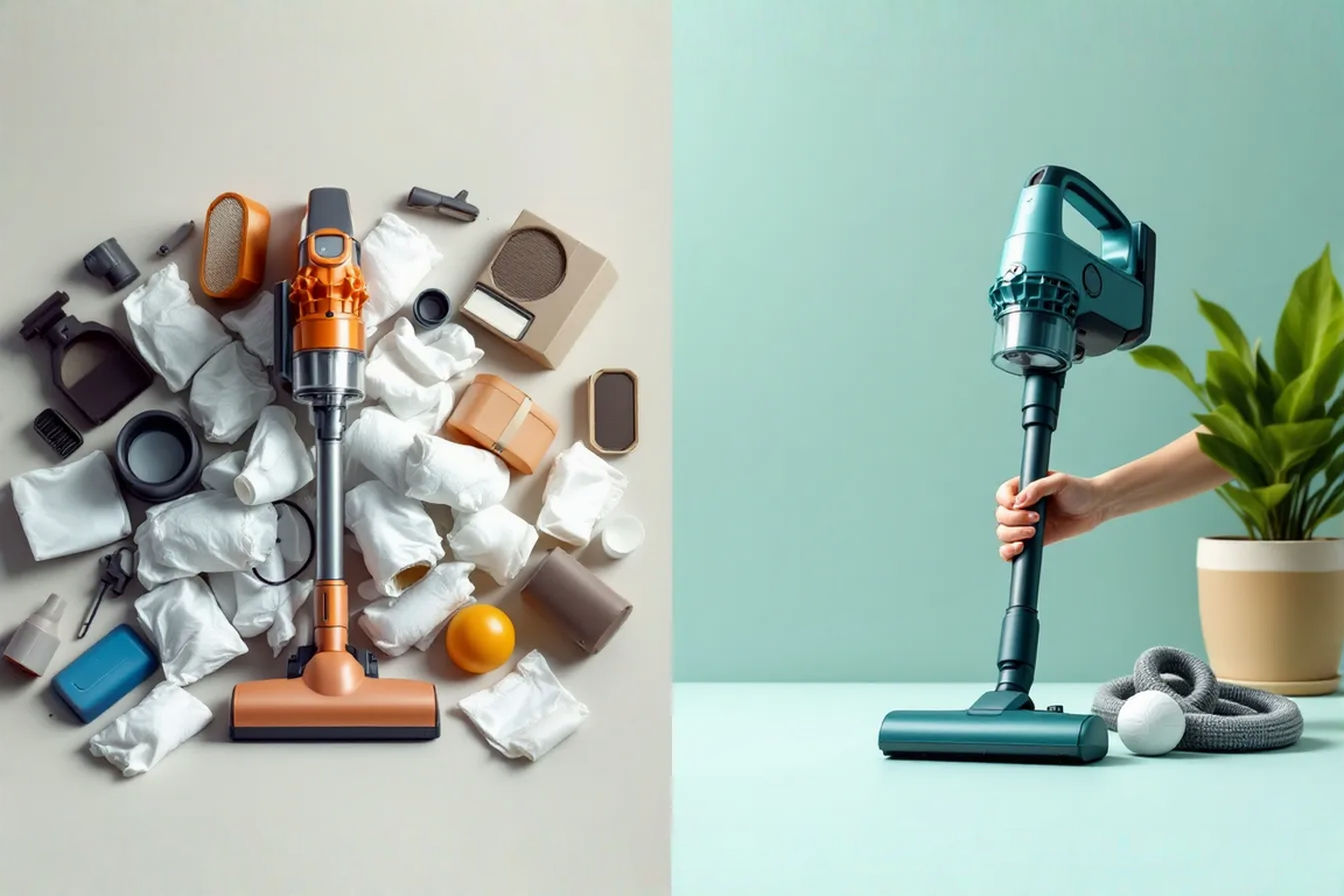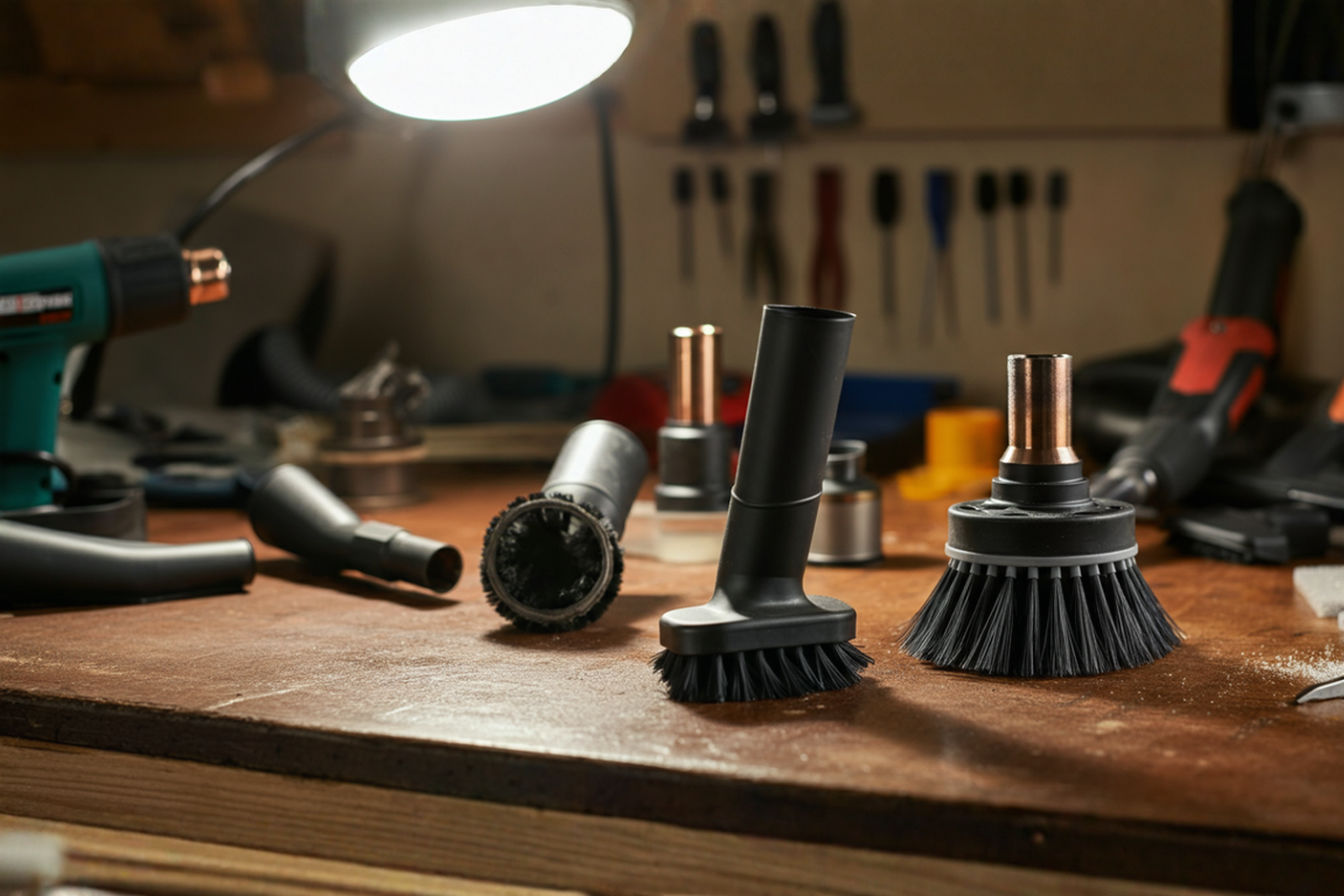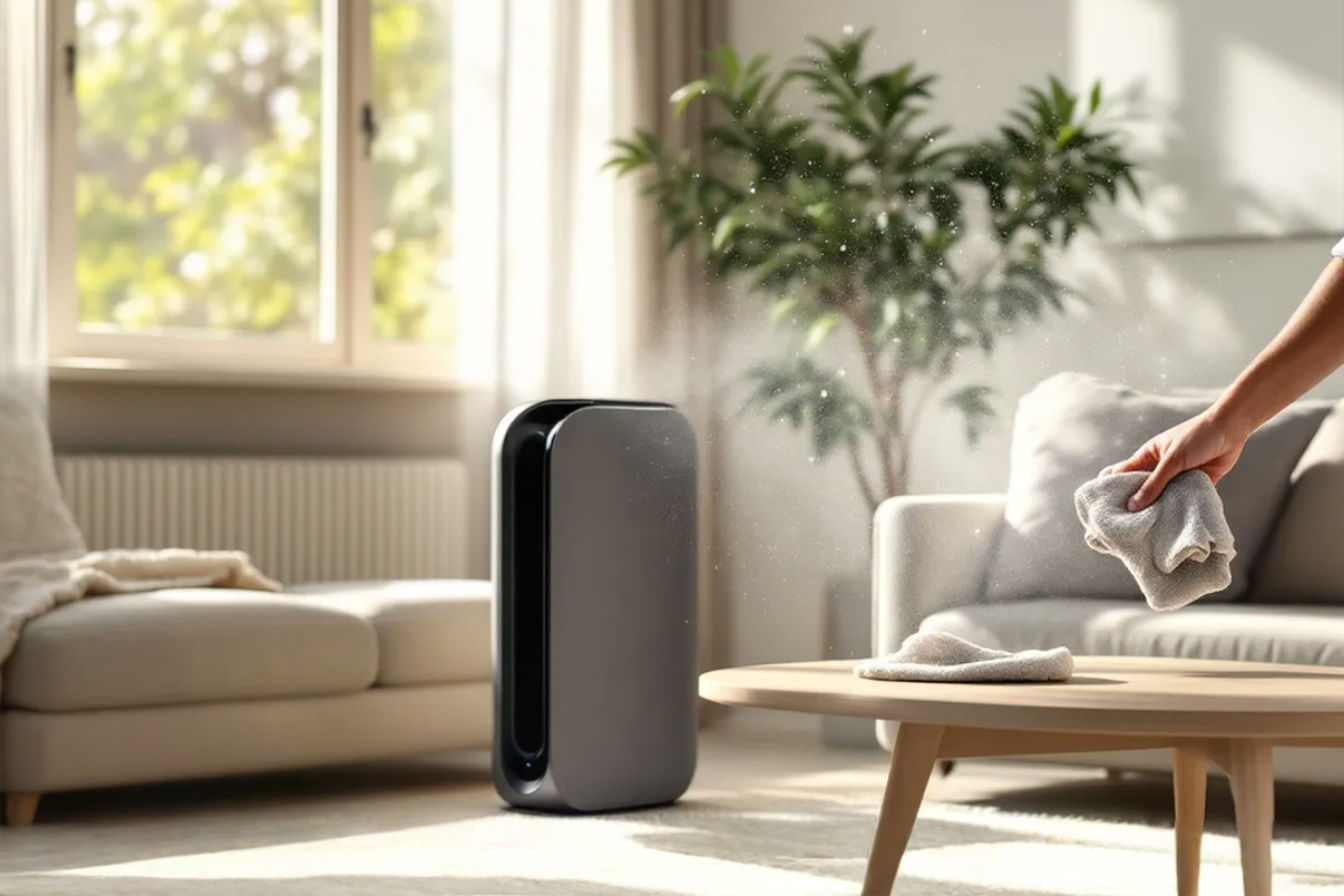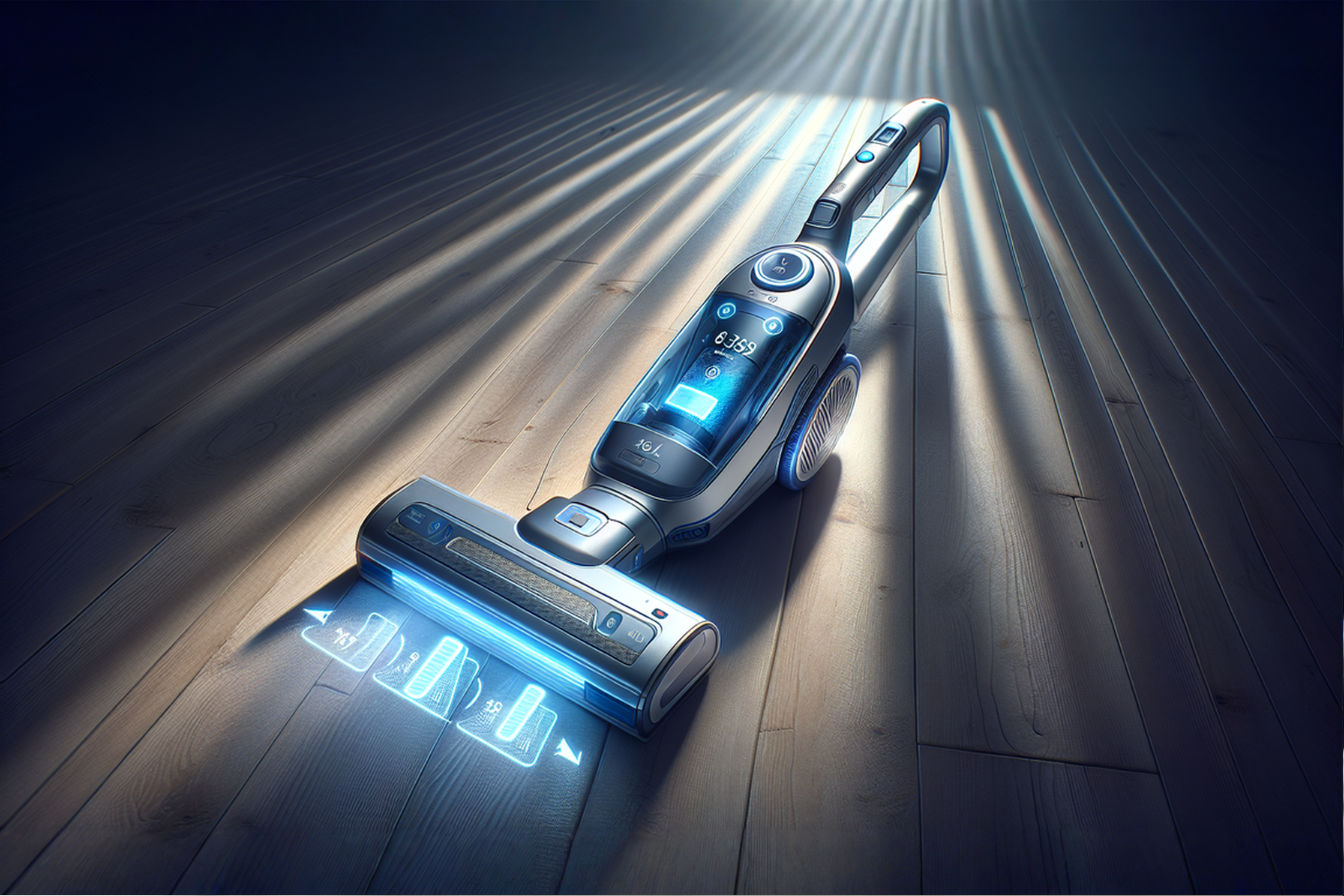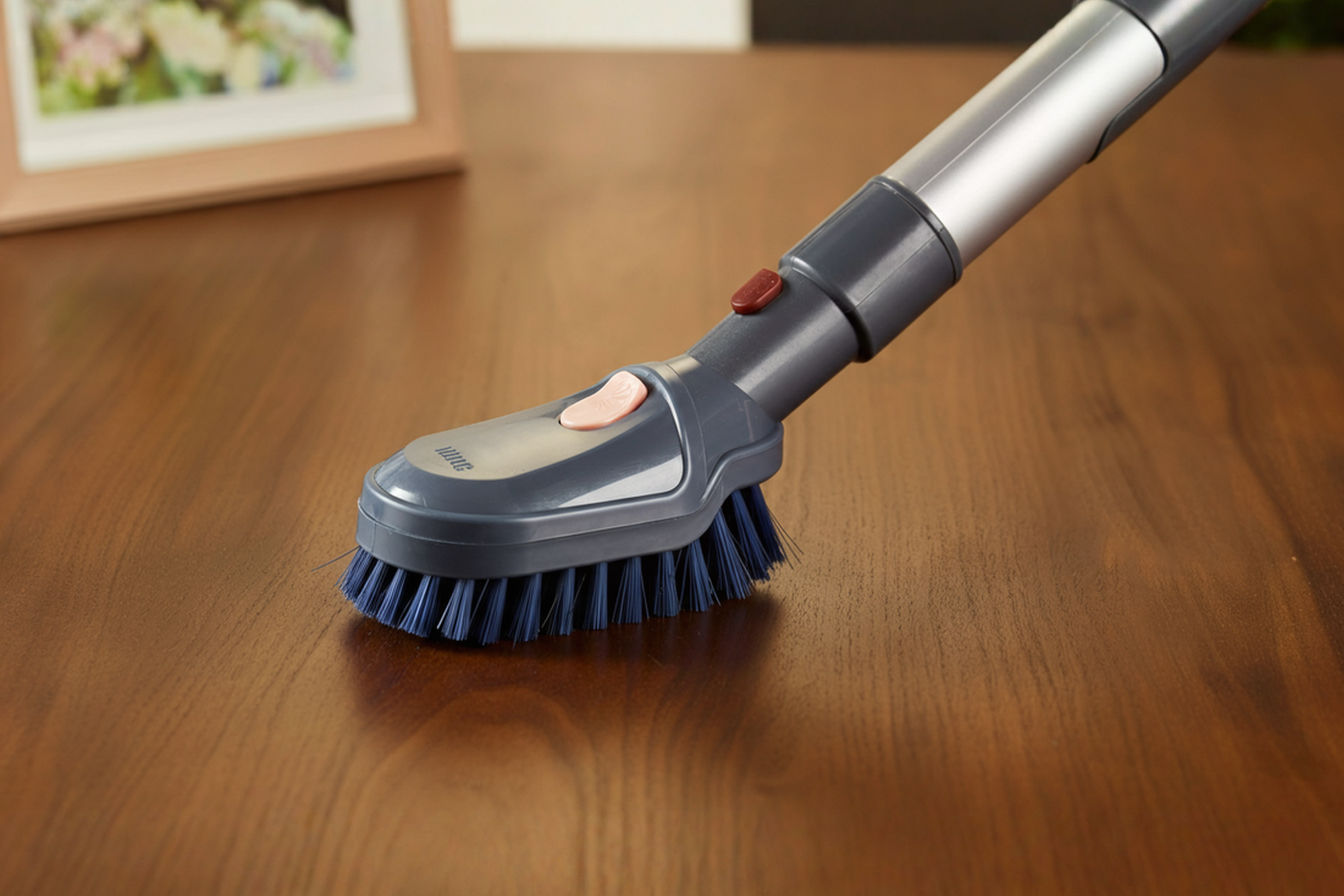Plastic Reduction Strategies: Minimizing Disposable Vacuum Cleaner Components in Your Routine
Learn how to minimize environmental impact from vacuum cleaners through sustainable alternatives, proper maintenance, and smart shopping choices—without compromising on cleanliness.
This post may contain affiliate links. If you make a purchase through these links, we may earn a commission at no additional cost to you.
In the quest for a cleaner home, we often overlook the environmental impact of our cleaning tools themselves. Vacuum cleaners, while essential for maintaining healthy living spaces, contribute significantly to plastic waste through their disposable components. These parts—from dust bags and filters to belts and brushes—frequently need replacement and typically end up in landfills, adding to our planet’s growing plastic problem.
This comprehensive guide explores practical strategies to minimize plastic waste from vacuum cleaner components without sacrificing cleaning effectiveness. By making thoughtful choices about the vacuum systems we use and how we maintain them, we can significantly reduce our environmental footprint while continuing to enjoy clean living spaces.
Understanding the Environmental Impact of Disposable Vacuum Components
Before diving into solutions, it’s important to recognize the scope of the problem. Modern vacuum cleaners contain numerous disposable parts that require regular replacement throughout the appliance’s lifespan.
Common disposable vacuum components include:
- Dust bags (often made from synthetic materials)
- HEPA and motor filters (typically plastic-based)
- Drive belts (usually rubber or synthetic compounds)
- Brush rolls (containing plastic bristles and components)
- Attachment tools (often made entirely of plastic)
- Packaging for replacement parts
These components create a continuous stream of waste as they’re replaced. A typical household might discard 4-12 vacuum bags annually, plus filters and other components, generating pounds of plastic waste per year. When multiplied across millions of households worldwide, this creates a substantial environmental burden.
The environmental consequences extend beyond mere waste accumulation. The production of these components requires petroleum resources, energy for manufacturing, and transportation. Additionally, many vacuum components contain multiple materials that are difficult to separate for recycling, meaning they frequently end up in landfills where they may take hundreds of years to decompose, if at all.
Assessing Your Current Vacuum System
The journey toward more sustainable vacuum cleaning begins with a thorough assessment of your current system. Understanding what you’re working with provides a baseline for improvement.
Start by identifying all the disposable components in your vacuum model. Consult your owner’s manual or the manufacturer’s website to create a comprehensive list. Note which parts require regular replacement and their composition. This inventory forms the foundation of your reduction strategy.
Next, evaluate how frequently you replace each component. Track this over several months to establish patterns. Do you replace the filter monthly? How often do dust bags need changing? This data helps prioritize your efforts based on which components generate the most waste.
With this information, you can roughly calculate your vacuum’s “plastic footprint.” Consider the weight and material of each disposable part multiplied by the frequency of replacement. This exercise often reveals surprising insights about which components contribute most significantly to your waste stream.
Finally, determine which components offer the greatest opportunities for improvement. Focus initially on items replaced most frequently or those with readily available sustainable alternatives. This targeted approach yields immediate environmental benefits while creating momentum for broader changes.
Sustainable Alternatives to Disposable Vacuum Bags
Vacuum bags represent one of the most frequently replaced components in traditional vacuum systems, making them an excellent starting point for waste reduction efforts.
Reusable cloth and fabric vacuum bags offer a compelling alternative to disposable options. These durable bags are typically made from tightly woven materials designed to trap dust while allowing air to flow through. After use, they can be emptied, washed, and reused dozens of times before needing replacement. While the initial investment may be higher than disposable bags, the long-term cost savings and waste reduction make them economically and environmentally advantageous.
Bagless vacuum systems eliminate the need for bags entirely by collecting debris in a removable canister. These systems reduce waste from bags but require consideration of other factors. The filters in bagless systems may need more frequent cleaning or replacement, potentially offsetting some environmental benefits. When selecting a bagless vacuum, prioritize models with washable, reusable filters to maximize environmental advantages.
For those committed to using existing bagged vacuums, several strategies can extend bag life. Removing larger debris by hand before vacuuming reduces the volume collected in bags. Similarly, emptying bags when they’re 2/3 full rather than completely full can maintain suction efficiency while maximizing capacity utilization. Some users successfully extend bag life by carefully emptying and reusing disposable bags several times before replacement, though this works better with some bag designs than others.
Proper maintenance of reusable bags ensures optimal performance and longevity. After emptying, shake bags thoroughly outdoors to remove fine particles. Wash fabric bags according to manufacturer instructions, typically using mild detergent and air drying completely before reinstallation. Store spare bags in clean, dry locations to prevent contamination. With proper care, quality reusable bags can last for years, dramatically reducing waste.
Reducing Plastic Waste from Vacuum Filters
Filters constitute another significant source of plastic waste in vacuum systems. Most vacuums contain multiple filters—primarily HEPA filters for capturing fine particles and motor filters protecting internal components.
Washable and reusable HEPA filters represent a significant advancement in sustainable vacuum design. These filters can be rinsed clean when they become clogged, eliminating the need for frequent replacements. High-quality washable filters maintain their efficiency through numerous cleaning cycles, though they typically require complete drying before reinstallation to prevent mold growth and maintain proper airflow.
Extending filter life through proper maintenance represents another effective strategy. Regular cleaning based on manufacturer recommendations prevents premature clogging and degradation. Many users find that gently tapping filters to remove surface debris between deep cleanings helps maintain airflow and extends intervals between washes or replacements. Additionally, pre-filtering strategies, such as ensuring bags or dust canisters don’t become overfilled, reduces the burden on secondary filtration systems.
Alternative filtration materials offer promising developments in sustainable vacuum design. Some manufacturers now produce filters from more environmentally friendly materials, including biodegradable components or recycled content. Others explore filtration systems inspired by natural processes that require fewer replaceable parts. Though these innovations remain somewhat limited in mainstream products, supporting brands developing such alternatives encourages further advancement.
Understanding when to replace versus when to clean filters requires attention to manufacturer guidelines and filter performance. Visual inspection often reveals when cleaning no longer restores functionality—signs include permanent discoloration, structural damage, or persistent odors. Many manufacturers specify a maximum number of cleaning cycles before replacement becomes necessary. While pushing beyond these limits might seem environmentally beneficial, significantly degraded filters compromise indoor air quality and may strain other vacuum components, potentially creating more waste through premature appliance failure.
Sustainable Approaches to Vacuum Belts and Brushes
Drive belts and brush rolls might be replaced less frequently than bags and filters, but their environmental impact remains significant due to their typically non-recyclable composition and the manufacturing resources they require.
Durable alternatives to standard belts can dramatically reduce replacement frequency. Many vacuum manufacturers offer “premium” or “long-life” belt options that, while more expensive initially, last substantially longer than standard belts. These enhanced belts often use more resilient rubber compounds or reinforced designs that resist stretching and breaking. Some newer vacuum models feature geared belt systems or direct-drive motors that eliminate traditional belts entirely, further reducing waste.
Proper maintenance significantly extends component life regardless of belt type. Regular inspection helps identify early signs of wear before catastrophic failure occurs. Cleaning brush rolls to remove entangled hair and fibers prevents excessive belt strain. Adjusting brush height appropriately for different floor surfaces reduces unnecessary friction. Simple practices like turning off the vacuum when the brush encounters resistance (such as when stuck on carpet fringe) prevents belt burnout.
The repair-versus-replace decision significantly impacts sustainability. Many brush rolls can be restored to like-new condition through relatively simple maintenance. Removing accumulated debris, replacing worn bristles (when possible), and cleaning bearing assemblies often revitalizes performance without replacement. For those with basic technical skills, replacing just the worn components of a brush assembly rather than the entire unit provides substantial waste reduction.
Modern brush designs increasingly incorporate sustainable materials and modular construction. Some manufacturers now offer brush rolls with replaceable bristle strips, allowing for partial replacement of worn components. Others use recycled or biodegradable materials in non-critical components. When selecting a new vacuum or replacement parts, these design features merit consideration alongside cleaning performance metrics.
Eco-Friendly Vacuum Cleaner Brands and Models
For those in the market for a new vacuum, choosing an environmentally conscious model represents a significant opportunity to reduce long-term waste. Several manufacturers have made substantial commitments to sustainability in recent years.
Leading sustainable vacuum manufacturers distinguish themselves through multiple approaches. Some prioritize durability and repairability, designing products intended to last decades rather than years. Others focus on minimizing disposable components through innovative filtration systems and reusable parts. Still others emphasize responsible materials selection, incorporating recycled plastics, biodegradable components, or reduced packaging. Notable market leaders include Miele (known for exceptional longevity), Dyson (for bagless technology with washable filters), and Gtech (for energy efficiency and simplified design).
Key features that indicate eco-friendly vacuum design include:
- Robust warranties exceeding industry standards
- Availability of replacement parts for extended periods
- Modular construction facilitating repairs
- Energy-efficient motors with variable power settings
- Reusable or long-life filtration systems
- Minimal proprietary components that limit repair options
- Responsible packaging using recycled or minimal materials
- Take-back programs for end-of-life recycling
Cost comparisons between sustainable and conventional models reveal nuanced considerations. While eco-friendly vacuums often carry higher initial price tags, their total lifetime cost frequently proves competitive or advantageous. The reduced need for replacement parts, extended operational lifespan, and improved energy efficiency generate ongoing savings that offset higher purchase prices. Additionally, many sustainable models maintain stronger resale value, further enhancing their economic proposition.
The long-term value proposition extends beyond direct financial calculations to include convenience factors and environmental benefits. High-quality sustainable vacuums typically require less frequent maintenance, experience fewer breakdowns, and deliver more consistent performance throughout their lifespan. When combined with reduced environmental impact from manufacturing, operation, and disposal, these factors create compelling comprehensive value.
Creating a Maintenance Routine to Minimize Waste
Perhaps the most accessible strategy for reducing vacuum-related waste involves implementing a thoughtful maintenance routine. Proper care dramatically extends component life regardless of vacuum type or design.
Establishing a regular cleaning schedule for reusable components prevents performance degradation that might otherwise prompt replacement. Weekly emptying of dust canisters, monthly washing of reusable filters, and quarterly deep cleaning of brush rolls and attachments represents a reasonable baseline for most households. This schedule should be adjusted based on usage patterns, home size, and the presence of pets or other factors affecting debris volume.
Preventative maintenance addresses potential problems before they necessitate component replacement. This includes checking belt tension, inspecting electrical cords for damage, clearing potential blockages in hoses and tubes, and lubricating moving parts according to manufacturer recommendations. Many users find that dedicating 15 minutes monthly to preventative maintenance saves hours of troubleshooting and repair later while significantly reducing waste from premature part replacement.
Effective troubleshooting skills enable addressing common issues without defaulting to component replacement. When suction decreases, systematically checking for blockages often resolves the problem without filter replacement. Similarly, unusual noises rarely require immediate parts replacement—they typically indicate specific issues with identified solutions. Developing basic diagnostic abilities through owner’s manual review and online resources empowers users to distinguish between truly failed components and those needing simple maintenance.
Proper storage extends component life considerably. Storing vacuums and attachments in clean, dry environments prevents unnecessary deterioration. Keeping the vacuum unplugged when not in use prevents electrical component stress. Some components, particularly filters and brush rolls, benefit from being removed and stored separately to maintain proper shape and prevent permanent deformation. These simple practices require minimal effort yet yield substantial benefits for component longevity.
Beyond the Vacuum: Complementary Cleaning Methods
Reducing reliance on vacuum cleaning itself offers another avenue for minimizing associated waste. While vacuums excel at certain cleaning tasks, incorporating complementary methods creates a more balanced, sustainable approach.
Traditional cleaning tools like brooms, dustpans, and mops effectively handle many routine cleaning needs without disposable components. High-quality versions of these tools can last decades with minimal maintenance, dramatically reducing waste compared to vacuum components. For many hard floor surfaces, these traditional approaches remain highly effective for daily cleaning, with vacuuming reserved for less frequent deep cleaning.
Sustainable floor cleaning alternatives continue evolving beyond traditional tools. Microfiber systems capture dust through electrostatic attraction without motorized assistance. Steam cleaners sanitize surfaces using only water, eliminating chemical waste while providing deep cleaning. Robotic cleaning systems, while requiring energy, often use less power than full-sized vacuums and may employ more durable filtration systems with less frequent replacement needs.
Integrating multiple approaches yields optimal results while minimizing environmental impact. One effective strategy involves using manual methods for daily maintenance cleaning, reserving vacuum use for weekly deep cleaning. This approach substantially reduces the operational hours of vacuum equipment, extending the lifespan of all components. Additionally, proper pre-cleaning (such as picking up larger debris by hand) reduces strain on vacuum systems during their use.
Building a holistic plastic-reduction cleaning strategy extends beyond tool selection to include preventative measures. Effective entry mats reduce floor debris, decreasing necessary cleaning frequency. Similarly, no-shoe policies significantly reduce dirt introduction. Regular dusting of elevated surfaces prevents particles from settling on floors, while prompt attention to spills prevents the need for intensive cleaning later. These preventative approaches reduce cleaning requirements overall, consequently decreasing tool wear and associated waste.
Advocating for Industry Change
While individual actions significantly reduce personal waste contribution, broader industry transformation requires collective advocacy and market influence.
Supporting brands with demonstrated sustainable practices represents powerful consumer activism. Purchasing decisions that prioritize repairability, component longevity, and responsible materials send clear market signals. Researching company policies regarding planned obsolescence, right-to-repair compliance, and environmental commitments helps identify truly sustainable manufacturers rather than those engaged in “greenwashing.”
Direct communication with manufacturers about packaging and design concerns can drive meaningful change. Customer feedback through official channels, social media engagement, and product reviews influences company priorities, particularly when focused on specific, actionable improvements rather than general complaints. Manufacturers increasingly recognize sustainability as a competitive advantage, making them receptive to constructive suggestions for improvement.
Participation in take-back and recycling programs supports circular economy development. Some vacuum manufacturers now offer component recycling services, particularly for electronic parts and batteries. Others provide trade-in incentives for upgrading to more efficient models. Supporting these programs, even when slightly less convenient than standard disposal, helps establish their economic viability and encourages expansion.
Community initiatives for responsible disposal extend impact beyond individual actions. Organizing neighborhood collection events for hard-to-recycle components, establishing repair cafés that teach maintenance skills, and sharing sustainable practices through community groups amplifies individual efforts. These collective approaches often achieve economies of scale that make sustainable options more accessible while building momentum for broader change.
Conclusion
Reducing plastic waste from vacuum cleaner components represents a meaningful contribution to environmental sustainability without sacrificing clean living spaces. Through thoughtful product selection, diligent maintenance, and innovative alternatives, significant waste reduction becomes readily achievable.
The strategies outlined in this guide offer multiple entry points for improvement regardless of current vacuum system or budget constraints. From simple maintenance enhancements to complete system replacement with sustainable alternatives, positive changes remain accessible across varied circumstances. Most importantly, these approaches typically enhance cleaning performance and convenience while reducing environmental impact, creating true win-win scenarios.
The long-term environmental impact of implementing these changes extends beyond immediate waste reduction. Decreased demand for disposable components reduces resources devoted to their production, packaging, and transportation. Fewer components entering waste streams lessens burden on disposal systems and reduces pollution from inadequate waste management. Collectively, these effects contribute meaningfully to broader environmental health while establishing consumption patterns that future generations can sustainably maintain.
As consumers, our choices powerfully shape market offerings. By prioritizing sustainability in vacuum cleaner components and maintenance practices, we reduce our personal environmental footprint and contribute to system-wide transformation toward more responsible product design and manufacturing. These individual actions, multiplied across millions of households, create substantial positive impact while demonstrating the viability and desirability of sustainable alternatives.

